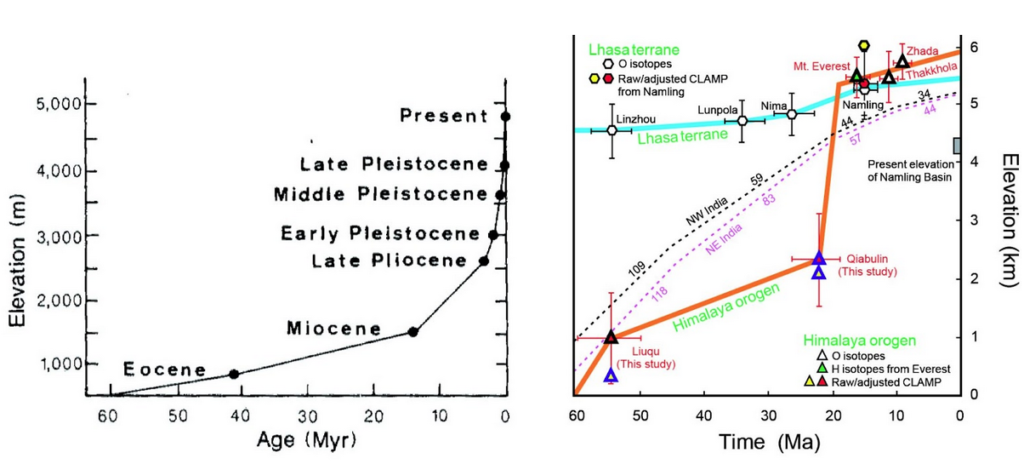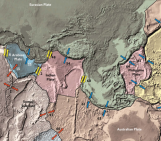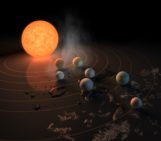
The idea that the Pleistocene glaciation was caused by a late Cenozoic rise of mountain ranges had been developed since the mid 19th century. Although this original idea did not hold, new arguments for a relation between a late Cenozoic uplift of mountains and global cooling were presented from the 1970s onward. These arguments focused on how increased surface elevations would affect the albedo, the circulation of the atmosphere, and chemical weathering, which acts as a carbon dioxide sink. A physical mechanism that would explain the actual late Cenozoic uplift, was, however, not presented. Instead, Earth scientists focused on possible proxies that may document the uplift. Molnar and England (1990) addressed this limitation and showed that the cause-and-effect relationships presumed in the lines of arguments are far from clear.
After a brief review of the Cenozoic climate record and an introduction to concepts of uplift (a contracted version of England & Molnar, 1990), Molnar and England discussed the significance of geomorphological, sedimentological, and palaeobotanical data previously interpreted as evidence for a recent uplift of mountain ranges. The authors showed that much of this evidence is rather a consequence of climate cooling, which leads to the chicken or egg issue. Molnar and England further addressed complexities in the relation between climate, precipitation, and erosion, and explained that simple ideas like “more precipitation would lead to more erosion, or vice versa” must not always hold. Independently, Molnar and England acknowledged that there are processes linking climate and elevation and suggest “chicken and egg” as an alternative view. This view includes that the construction of the Himalayas, the Tibetan Plateau, and other high elevation areas during the Cenozoic facilitated long-term climate cooling. Moreover, the authors proposed a positive feedback mechanism between climate change, weathering, erosion, and isostatic rebound, which may resolve the illusion of global, accelerated uplift of mountain ranges.

Inferred history of uplift of the Tibetan Plateau and the Himalayas. Left: Uplift history as presented in Molnar and England (1990). The elevation appears to increase exponentially. High elevations above 3 km were reached only some 2-3 million years ago. The right diagram shows a recent compilation from Ding et al. (2017). This dataset suggests that both the Tibetan Plateau and the Himalayas had similar elevations than those of today since about 20 Ma.
Perhaps one of the most peculiar aspects of the chicken or egg paper is how it merges multiple lines of arguments to provide a glimpse of Earth system science. Over the past three decades, the paper has stimulated numerous research questions, particularly with a focus on climate-tectonic interactions. We now better understand that there was no late Cenozoic pulse of global surface uplift and that mountain ranges like the Himalayas or European Alps had risen to high elevations already some 20 million years ago (e.g., Campani et al., 2012; Gébelin et al., 2013; Ding et al., 2017). There is also evidence that the Pleistocene glaciation did not simply result in higher erosion rates (e.g., Willenbring & von Blanckenburg, 2010; Schildgen et al., 2018; Lenard et al., 2020), although this topic remains a matter of debate (e.g., Herman et al., 2013: Willett et al., 2020; Earth Surface Dynamics Discussions). Moreover, mountain heights reflect a balance between gravitational stresses, tectonic stresses, and the strength of rocks (e.g., Lamb, 2006), and there is no evidence that these factors could change suddenly at a global scale. The late Cenozoic uplift of mountain ranges therefore remains also mechanically difficult to explain.
Sebastien Castelltort and Armin Dielforder contributed to the discussion on Reddit (https://www.reddit.com/r/TSMustRead/comments/pbsh5a/ts_mustread_molnar_england_1990_late_cenozoic/)
Written by Armin Dielforder, David Fernández-Blanco, Marta Marchegiano, and the TS Must-Read team
References
Campani, M., et al. (2012). Miocene paleotopography of the Central Alps. Earth and Planetary Science Letters 337–338, 174–185. http://dx.doi.org/10.1016/j.epsl.2012.05.017
Ding, L., et al. (2017). Quantifying the rise of the Himalaya orogen and implications for the South Asian monsoon. Geology 45, 215–218. https://doi.org/10.1130/G38583.1
Gébelin, A., et al. (2013). The Miocene elevation of Mount Everest. Geology 41, 799–802. https://doi.org/10.1130/G34331.1
Herman, F., et al. (2013). Worldwide acceleration of mountain erosion under a cooling climate. Nature, 504, 423-426. https://doi.org/10.1038/nature12877
Lamb, S. (2006). Shear stresses on megathrusts: Implications for mountain building behind subduction zones. Journal of Geophysical Research 111, B07401. https://doi.org/10.1029/2005JB003916
Lenard, S. J. P., et al. (2020). Steady erosion rates in the Himalayas through late Cenozoic climatic changes. Nature Geosciences 13, 448–452. https://doi.org/10.1038/s41561-020-0585-2
Molnar, P., & England, P. (1990). Late Cenozoic uplift of mountain ranges and global climate change: chicken or egg?. Nature 346, 29–34 (1990). https://doi.org/10.1038/346029a0
Schildgen T. F., et al. (2018). Spatial correlation bias in late-Cenozoic erosion histories derived from thermochronology. Nature 559, 90-93. https://doi.org/10.1038/s41586-018-0260-6
Willenbring, J. K., & von Blanckenburg, F. (2010). Long-term stability of global erosion rates and weathering during late-Cenozoic cooling. Nature 465, 211–214. https://doi.org/10.1038/nature09044
Willett, S. D., et al. (2021). Bias and error in modelling thermochronometric data: Resolving a potential increase in Plio-Pleistocene erosion rate. Earth Surface Dynamics, 9(5), 1153-1221.


